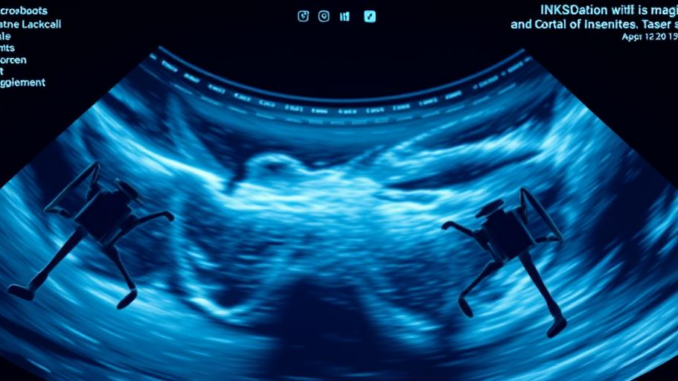
Summary
Caltech’s bioresorbable acoustic microrobots (BAM) are revolutionizing targeted drug delivery. These microscopic spheres navigate the body using magnetic fields and ultrasound, delivering therapeutics directly to diseased tissue before safely dissolving. This breakthrough offers a promising future for precision medicine, minimizing side effects and maximizing treatment efficacy.
TrueNAS by Esdebe: healthcare data storage that delivers value without sacrificing security.
** Main Story**
Microrobots? They’re not just science fiction anymore. These tiny machines are poised to revolutionize medical technology, especially when it comes to targeted drug delivery. I recently read about a fascinating development from a team at Caltech: bioresorbable acoustic microrobots, or BAMs. Think of them as miniature spheres capable of navigating the body’s intricate pathways to deliver drugs directly to diseased cells. This isn’t just theoretical; they’ve already shown impressive results shrinking bladder tumors in mice, suggesting we’re on the cusp of a new era in personalized medicine.
How Do These Microscopic Marvels Work?
So, how do these things actually work? Well, these microrobots are incredibly small, about the width of a human hair, and they’re made from a biocompatible hydrogel called poly(ethylene glycol) diacrylate. It starts as a liquid but then solidifies into a polymer network, which can hold a significant amount of fluid – including life saving drugs. But it’s their unique design that really makes them special. They are each designed and built with several key features:
- Magnetic Navigation: Imagine tiny magnets embedded within each robot. Researchers use external magnetic fields to steer them precisely to where they need to go. It’s like having a GPS for individual cells!
- Ultrasound Propulsion: Trapped within each little robot is an air bubble. When exposed to ultrasound, this bubble vibrates, which then propels the device forward. Plus, it helps with imaging too.
- Targeted Drug Release: Here’s where the magic happens. The robots are engineered to only release their therapeutic payload once they’ve reached the specific target site. It’s all about maximizing effectiveness while minimizing side effects on healthy tissues, and it’s about time.
- Bioresorbability: And here’s the kicker: after their mission is complete, these microrobots safely dissolve within the body, leaving no harmful trace behind. Think about that; no long-term side effects, no additional procedures to remove them.
That combination of precise navigation, targeted delivery, and bioresorbability really sets BAMs apart from previous attempts at microrobotic drug delivery. It addresses many of the safety and efficacy concerns that have held the field back.
The Challenges of Being Small
We’ve been talking about microrobots for a while now, and it’s about time they started to become a reality. Getting there, hasn’t been easy. Navigating the complex fluids inside the human body, like blood and urine, is a significant hurdle for microscopic devices. It’s like trying to swim through molasses, but on a cellular scale.
And then, there’s the biocompatibility issue, ensuring the robots won’t cause adverse reactions and will eventually dissolve safely in the body. Can you imagine the problems if they start to clump up in your blood stream? However, the Caltech team’s design seems to have cracked these problems. Their robots have a hydrophilic exterior, which prevents clumping, and their bioresorbable nature takes care of the safety issues.
What’s Next?
So far, the preclinical trials are looking good. The BAMs were able to deliver therapeutic payloads that significantly reduced the size of bladder tumors in mice over a 21-day period. It’s encouraging, right? This has the potential to change cancer treatment, and many other areas of medicine too.
Think about these potential applications:
- Targeted drug delivery for various diseases: BAMs could be adapted to deliver different drugs to specific tissues, helping to treat a wide range of medical conditions.
- Precision surgery: Imagine microrobots performing minimally invasive surgery in areas that are currently difficult to access with traditional methods.
- Biosensing and diagnostics: Microrobots could collect diagnostic information or monitor how a patient is responding to treatment within the body.
It really opens up so many doors to helping people.
A New Era?
BAMs represent a major leap forward in medical technology. The pinpoint accuracy could minimize side effects and maximize the effectiveness of many treatments. As the technology develops, it could play a vital role in personalized healthcare, tailoring treatments to individual patients’ needs. I think this is an exciting new path in precision medicine, which could be the next big thing in patient care. It’s February 25, 2025, and who knows what the future holds, but it looks promising!


The bioresorbable aspect is fascinating. Beyond tumor shrinkage in mice, could this technology be adapted to address localized inflammation or deliver regenerative medicine therapies directly to damaged tissues?
That’s a fantastic point! The potential for localized inflammation control and targeted regenerative therapies is definitely a promising avenue for exploration. The bioresorbable nature minimizes long term impacts, making it ideal for delivering growth factors or anti-inflammatory agents directly to damaged tissues. It will be interesting to see how the applications expand!
Editor: MedTechNews.Uk
Thank you to our Sponsor Esdebe
The use of ultrasound for propulsion and imaging is clever! How might the frequency and intensity of the ultrasound be adjusted to optimize navigation through different tissue densities, and could this be combined with real-time feedback for even more precise control?
That’s a brilliant question! Optimizing ultrasound parameters for navigation through different tissue densities is key. Real-time feedback integration could involve sensors on the microrobots, creating a closed-loop system for unparalleled precision. Exploring AI for adaptive control could also lead to some cool breakthroughs!
Editor: MedTechNews.Uk
Thank you to our Sponsor Esdebe
Tiny robots delivering drugs like microscopic pizza delivery guys? I hope they accept contactless payments and don’t get stuck in the bloodstream equivalent of rush hour. Seriously though, the bladder tumor shrinkage in mice is impressive. Next stop, human-sized problems!